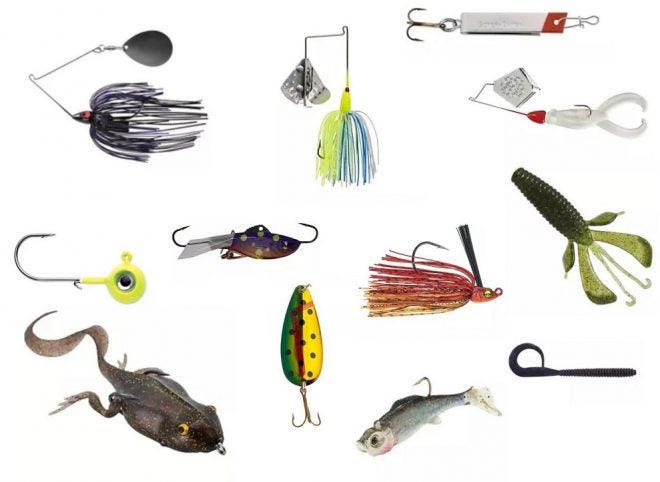Common Fishing Lure Comparison Guide – The Good, the Bad, the Ugly
Travis Olander 01.27.23

Live bait works great, but a fishing lure has obvious advantages: they’re reusable, they’re made to attract specific fish in particular conditions, and they’re highly controllable. A fishing lure can come in all shapes and sizes. There are literally thousands of kinds available for just about every type of game and locale. There are so many, in fact, that picking the right lure can get confusing. Let’s look at the most common fishing lure options by category and go over what each one’s best suited for.
Fishing Lure – Jigs
Jigs come in various shapes and sizes: Simple hooked eyes, skirted swim jigs, hair jigs, tube jigs, soft plastic jigs – the list goes on. Regardless of their appearance, jigs all share the same purpose and action: they’re sinking bottom lures that are made to swim up and down. In doing so, they mimic the action of baitfish and small dwelling species like crays, insects, and minnows.
Jigs have a weighted head one the leading end, and one or more hooks on the distal end. To use a jig effectively, let it sink to the bottom. Once your line’s slack, pop and whip your rod up and down to get that jumpy, frenetic action of a small live bait. Jigs are the king of bass fishing, and they work well on Perch, Catfish, Walleye, and Pike. Jigs can be made even more attractive by tipping them with live bait – worms – or soft plastics.
Fishing Lure – Spinnerbaits
Spinnerbaits use rotating spoon blades to produce flashy action and vibrations. Used in open water, a spinnerbait provides a surefire way to attract some excited strikes. They’re excellent at picking up Bass, Pike, Muskie, and Trout.
To produce action, the spinnerbait can be pulled in a steady, consistent retrieve or it can be made to flip and rotate with fast, stop-and-go pulls. Spinners work best in water with at least moderate visibility and little vegetation, but their vibration also makes them capable in deeper, darker, and turbid water. Most spinners are equipped with one oblong blade, typically made to reflect with a gold or silver sheen. The hook is usually covered with a skirt, but soft plastics work just as well.
Fishing Lure – Buzzbaits
Although they look identical to a skirted spinner, the propeller-bladed buzzbait serves a different purpose. Buzzbaits (like the LOUDBUZZ) are topwater lures primarily intended for Bass. Their propellers disrupt the surface of the water, causing splashes and turbulence. Because these lures are meant to ride along the surface, they’re great at luring fish out from under shaded cover and dense vegetation. Slow, consistent pulls work best. Given their surface action, buzzbaits should be used on days with low wind and calm tides.
Fishing Lure – Crankbaits
Crankbaits, also called plugs, are plastic lures that are made to resemble small baitfish or crayfish. Some are hollow, filled with beads to produce noise, while others may be gilded to produce a flash. The crankbait is designed to dive deeper as its reeled in, producing the evasive swimming action of prey.
This diving action is produced by a shaped, downward facing lip attached to the front of the bait. As the lure is reeled through the water, the lip forces the bait to shoot downward. The faster the lure’s pulled, the deeper it dives. Some crankbaits have segmented bodies and swiveling lips. These accoutrements allow the lure to more closely mimic the swimming action of small prey. Crankbaits (like Evergreen’s CR Series) produce the best “lifelike” action with stop-and-go pulls. When left idle, the crankbait will hover or float near the surface.
Fishing Lure – Spoons
Spoons got their name from their simple origins: These lures were once made from actual kitchen spoons with the handles cut off, and holes drilled for hooks and lines. The curved profile of the spoon is made to mimic the wobbly swimming action of an injured prey fish. Beautifully simple and reliable, spoons work for a variety of fish. Spoons are brightly colored or reflective to add to the attraction.
Spoons work best with vertical action or carefully paced trolling. Let the spoon sink below your target, then pull it up through the water to draw fish out from cover. Mastering the spoon means working out your speed relative to the size of the lure. Larger spoons swim slower. If you pull this lure too fast or slow, it won’t swim right.
Fishing Lure – Soft Plastics
Soft plastics reign supreme when it comes to finesse. These versatile soft baits mimic prey fish, worms, and crays. They can be fished as a jig trailer or tasty addition to a chatterbait or other lure. But they’re also used to make a variety of rigs, like Drop Shots, Carolinas, Wackies, and Texas and Ned rigs. Soft plastics are springy and tend to work best with sporadic, jerky, and cyclic movements.
Fishing Lure – Swimbaits
Swimbaits do exactly as their name implies: They swim. Well, it’s a bit more complicated than that. Swimbaits are designed to replace larger (and more expensive) live bait fish. These lures are incredibly liflife and mimic baby Shad, leeches, minnows, frogs, and of course, crayfish. Above all, natural movement is what a swimbait provides. Each type of swimbait will sport different segments along the body to reproduce certain movements. Because of their size, swimbaits are typically reserved for open waters, large casts, and big bites.
Proper use of a mimic swimbait depends entirely on the waters and the target. Employed properly, a swimbait can attract a truly massive trophy. Check out our quick break-down of Shimano’s new Armajoint 190SF World Flash. This crazy 7″ lure uses magnets and active flashing to produce some seriously life-life action.






